They knows when you’ve been sleeping
Recently, I attended a lecture by professor Michael Foster. He is one of the few people these days still making a dedicated study of yokai and his book was instrumental in researching my thesis. At his lecture, he discussed festivals that dealt with the theme of disciplining children for the bad things they have done and praising them for the good. The talk was focused on cultural festivals and how they are used and viewed in our ever globalizing world. For whom is the festival meant for and how does opening up a people’s cultural heritage to tourists and consumers affect the festival? But, what really interested me was the supernatural creatures involved in these ceremonies. Specifically Namagahe (なまはげ).
Now, my first introduction to Namagahe was last year when I roadtripped from Ishikawa to Aomori over Golden Week. When we were driving through Akita, I began to notice sign after sign which portrayed Oni with long hair and a big knife in hand. They were everywhere! At rest stops there were cardboard cutouts and themed snacks. On the roadsigns, their visage in red and blue.

I was interested, and did a little research. This was before the blog and I put the topic on the backburner until reminded of it by Michael Foster’s talk.
These nightmares come around to houses in the Oga Peninsula on December 31st and tear through the village, terrifying bad children and threatening to carry them off to the hills if they don’t repent their misdeeds. They often list off the bad things the child had done that year, only being assuaged from kidnapping with a bit of sake and food. In this, they reminded me of Santa Clause. They know when you’ve been bad or good, so be good for goodness sake! Because Santa has a big knife and looks hungry.
Oni and the Magic Beans
Just a quick post to celebrate Setsubun (節分), which is today. Held on the third of February every year, it represents the move from winter to spring. In order to prepare for this change, there is a kind of spring cleaning of evil spirits traditionally done.
As everyone knows, Oni hate beans(?) So baked soybeans known as fukumame (福豆) or lucky beans are great anti-oni devices that won’t put a strain on your budget!
So how do you take on the big, bad oni? Take a big handful of beans and let ’em fly while chanting, “Oni out! Luck in!” (鬼は外!福は内!) This will scare all the oni out of your house as well as any pesky spirits you may have invited in during this summer’s Kaidankai (怪談会)!
Now, pick the beans up off the floor, dusting off as necessary, and eat your age worth of the roasted demon slayers! This will protect you from evil and bring good luck for the rest of the year!
Any kind of bean will work if you can’t get your hands on fukumame. Good luck and good hunting!
A Menagerie of Masks
Have you ever played Majora’s Mask, the second game in the Legend of Zelda franchise released for the Nintendo 64? If you haven’t, go do it now. You can probably find a cheap N64 at your neighbor’s garage sale. And the game won’t put you back much, either. Or you could ROM it, but this blog doesn’t condone the free-sourcing of platformers on to PC. Not only is it technically illegal, but the experience is just not the same. But hey, I was raised on Nintendo platforms.
Where was I? Right, Majora’s Mask. If you have played it but never beat it, go do that now. I know some of the time loops can be frustrating, but it’s a good game!
Ok, beaten it? Or at least wiki’d the synopsis? (I’ll even hyperlink you to the site) Alright. Now, you’re probably wondering, “what does a Zelda game have to do with yokai, Michael?” Well, I’m getting there. By very nature of being a very awesome, very made in Japan series, these games are rife with homages to yokai. Whether some of them are intentional or not, I make no claim. But the one I’m going to talk about pretty much has to be. If you know anything about the games or just read Nintendo Power a lot in the late nineties, you will probably be familiar with this image. It is, of course, the Fierce Diety Mask, better known as the Oni Mask.
It is, of course, the Fierce Diety Mask, better known as the Oni Mask.
You get this mask for being awesome and collecting ALL the masks. Then, go through some easy dungeon bits, feel bad for the skull kid, and destroy his soul with this transforming mask. It turns Link in to a big tattoed guy with a sword that shoots LASERS.
Old school Zelda style. It’s pretty cool and makes the somewhat difficult final boss easy as beating up a deku scrub. Now, it is only colloquially that this mask is called the oni mask. In Japanese, it’s known as Kijin no Kamen (鬼神の仮面) which means fierce god. Astute readers may have noticed that, yes! Translated literally, this is the Oni God Mask! Which, I’m assuming is where Oni Link comes from. Despite the lack of horns or the loincloth, Link becomes an Oni. And is given a god-like power not even the Master Sword can truly match! Your sword shoots lasers. The Master Sword can’t do that unless you’re in an old game and have full hearts.
This is but one of the transforming masks given to Link on his journeys through the alternate universe Hyrule. And I like to think it’s the transformative powers of yokai that inspired them, rather than that of Sailor Moon. Wishful thinking, perhaps. But there’s an Oni Link, where is Magical Girl Link? Yeah, nowhere.
In Japanese folklore, Oni aren’t guys you wanna fuck with, even less so if they can shoot lasers from their swords (which I have found no records of, unfortunately…). They still are powerful creatures of menace and destruction that could own that creepy tentacle Majora in a few swipes of a club, too. So, did the creators of Zelda pull from their collective memory to make this mask and the other masks and monsters in the Zelda series? I think so. And after a few more playthroughs (purely for researches sake, of course), I’ll talk more about those! As well as the Keaton mask. I mean, come on… it’s a fox mask that summons a nine-tailed fox! Until I have time to play through them all!
今回の妖怪
I can’t imagine focusing this week’s yokai on anything but the oni.
And yet, I’ve basically introduced this oft red-skinned monster equated to the ogres of Shrek fame in Western context. Well, let’s see… They’re not the brightest obake on the block and don’t like mugwort. They eat the flesh of humans and are easily vanquished by boys who are associated with giant peaches. James could probably give them a run for their money…?
No? I don’t know what I was thinking. Sorry.
Inari Shrines, Inari Spirits
 I love Japanese foxes, or kitsune. I have a kitsune tattoo, I have book after book of kitsune-related folkstories, my thesis was going to be solely on transforming foxes until I decided to study a wider range of yokai (still researched an awesome fox story). And when I go to shrines, I have an uncanny ability to hone in on the often small and out-of-the-way fox shrines, or Inari-jinja (稲荷神社).
I love Japanese foxes, or kitsune. I have a kitsune tattoo, I have book after book of kitsune-related folkstories, my thesis was going to be solely on transforming foxes until I decided to study a wider range of yokai (still researched an awesome fox story). And when I go to shrines, I have an uncanny ability to hone in on the often small and out-of-the-way fox shrines, or Inari-jinja (稲荷神社).
I love these shrines, as well. In fact, they were probably the catalyst which got me obsessed with the world of Japanese folklore and mythology. I can still remember the first Inari shrine I ever went to, during my study abroad in Saitama. It was an exclusively fox shrine a five minute walk from my host parent’s house. They already lived in the middle of farmland, so nobody was ever there. It was a small shrine, hidden deep in the woods that surrounded it, but it was a beautiful place. I spent many hours there over the few months of the program, seeking shelter from typhoons and the world. That sounds super-emo, and it really shouldn’t.(^^;)))
But it really was my place where I could take in the grandeur of nature in peace. I had loved foxes and Inari before this, but communing with the god on such a level, Inari had become my god of choice in the Shinto pantheon. You know, intellectually speaking.
Needless to say, I order Inari-zushi (稲荷寿司) whenever I go out for sushi.
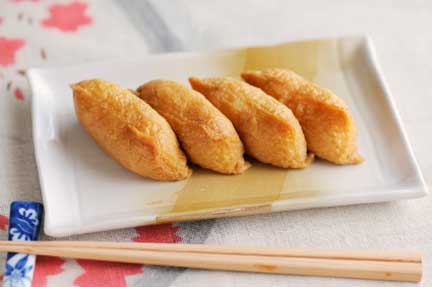
So, what does sweetened rice wrapped in fried tofu have to do with a fox god? That’s a very good question. And one with a very simple answer. Do you remember my post on kappa-zushi? If you do, thanks for reading my blog! If you don’t… Read it! It’s interesting stuff. Well, if you’re a devoted reader, or just skimmed my post, you’ll know that kappa-zushi is named after that little water god because of their predilection for cucumber, the main ingredient in kappa-zushi. It’s the same with Inari-zushi. The god just loves fried tofu! But really, who doesn’t? It’s delicious and cheap. Plus, Inari is the god of the harvest, which explains why a poich of fried tofu stuffed with lots of rice is her staple on the sushi menu. I wonder if she sends out the pure-white foxes that serve as her messengers to pick up an order on their way home from protecting the land and blessing the shit out of everything. She must get hungry after listening to the prayers of so many from all of her thousands of shrines! But really, the shrines are everywhere. I’ve seen them in back alleys of Sapporo, with tiny fox carvings and a little box for offerings and taking up huge plots of land in Kyoto with hundreds of Torii gates and many life-size fox statues!
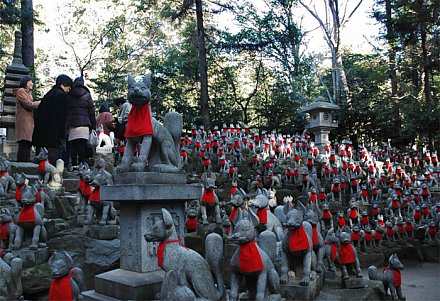
There is usually one in every shrine that houses more than a single god, too. This god is everywhere, which is lucky for me. It’s always terrible when your patron god is hard to get in touch with!
今回の妖怪
Bake-kitsune are the mischievous and shape-shifting cousins of Inari’s foxes, if the messengers of gods have extended families. Like in Western tradition, foxes are tricksters. They like to mess with people, transforming in to beautiful young women and waylaying travellers, tricking people dressed as monks on pilgrimages or old ladies in need of a hand. Those who fall under a foxes spell get in to l0ts of trouble with the law, lose their way in the mountains, make a family with a woman who turns out to be foxy in a more literal meaning, or end up eating horse manure they were sure was a delicious-looking meal.
I love bake-kitsune. If I had to rank them on my all-time best yokai list, they would easily and by far be ranked number one. Like all yokai, they can be good, bad, or neutral and in whatever form they take… Whether gods or tricksters or nine-tailed monsters trapped in the bodies of ninjas.
Bakemono and Bunka
Last week was Bunka no Hi (文化の日) or Culture Day, in Japan. This is a day that celebrates the history and culture of Japan by giving people the day off. It’s also traditionally a day where junior and senior high schools have their Culture Festival, as mine did. These things involve food booths, game corners, plays, and the like. The kids spend a lot of time and energy preparing for their class and club events, and the level is surprisingly high for middle school students! Normally, I would just be excited to get to play games and eat food while enjoying my kids hard work, but this year something else caught my eye.
Each grade does a play, and they’re usually pretty funny. This year my second graders did a very emo skit about boredom, death, and the Grim Reaper, while the third graders did a reinterpretation of Beauty and the Beast. But what stole the show, in my very biased opinion, was the first grader’s play about a group of kids in a Culture Festival just like this one making a haunted house. The kids, knowing my love of yokai actually asked me for some help with the props! I’m very proud of my Karakasa-obake (唐傘お化け). But I still had no idea what their skit would be about until opening day! It surpassed everything I was expecting of them. The play follows the class leader, Kenji, as he strives to make their haunted house a terrifying success. Then, in a dream sequence, he is greeted by girls in white robes claiming to be Obake and a man with a skull staff known as Mister Monster. They, for reasons I couldn’t quite follow, wanted Kenji to become a yokai and were recruiting him under that premise. hey show him how nobody respects him but he is inevitably saved by his soul, also portrayed as a yokai, and his friends. Not a story for the ages, but they did a good job.
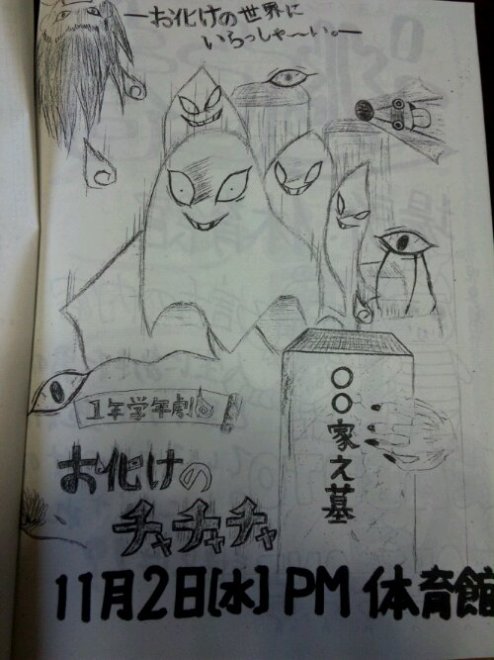
Throughout the play, the obake girls would sing songs and dance, upturning the normal paradigm of yokai as the thing to be feared by saying that they were much more afraid of humans than humans could ever be of them. My favorite part came when the girls saw the props for Kenji’s haunted house and laughed at how old they were. Real yokai, they exclaimed, were no longer the ancient Rokurokubi or the Karakasa-obake, but something newer! This was followed by the Thriller music coming on and the girls do a bit of the iconic dance. This was interesting to me, in that it backs up a trend I’ve seen recently of the younger generations having no real connection to the yokai that are their birthright. Instead, they are moving away from traditional yokai (insert anything culturally Japanese) to a more Western view of obake as the things that go bump in the night. And Michael Jackson. I’m not a cultural anthropologist, and even if I were, nobody would want to read my ramblings about how Japan is becoming Westernized and how this effects the price of tea. Hell, I wouldn’t want to write it, either… But it is interesting to see this cultural phenomenon of Westernization affect the people of Japan all the way down to the supernatural creatures that haunted the dreams of the bravest samurai.
今回の妖怪
When inanimate objects in Japan reach the ripe old age of one-hundred, they become Tsukomogami (付喪神), or artifact spirits. The karakasa-obake is one of these creatures.

It is a 100+ year old umbrella like the ones you see in old samurai movies. They need to be used for those one hundred years, so sorry, but that weed-whacker in your shed will never achieve sentience.
Like most yokai, they enjoy playing relatively harmless tricks on humans but can get pretty pissed off when you toss them out with the trash. Apparently they don’t like wasteful people very much. I guess I wouldn’t want to see perfectly good stuff thrown away when I’d been kept in use for a hundred years, either! I wonder if, somewhere in Japan, people have taken this attribute of Tsukomogami and put them to use in a pro-recycling project! If not, dibs!
Halloween In A Land of Yokai
Sorry for the ridiculous delay between posts! Seems crazy that my last one was in the heat of summer and now it’s already Halloween! I blame my lack of internet right now for the delay, but I know it’s really just laziness! I have a huge list of topics to write about, but they all want me to do lots of research to write academically-themed posts people probably don’t want to read. Plus, the laziness. So I’ll probably do those a little less often and focus on fluffier pieces that I can write without a constant connection to the internets. This is one of those pieces.
Halloween in Japan has exploded in popularity, even in comparison to last year! I like to think it’s JETs all over the country teaching their students about this awesome holiday causing this upward trend in Halloween trendiness, but it’s probably Disney and their damn Halloween themed days that’s doing it… But whatever the reason, Halloween stuff is in all the stores; right next to the Christmas crap that is so completely out of season it hurts.
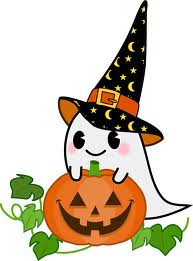
Kids in my Halloween classes draw me pictures of black cats nd jack-o’-lanterns and come to school dressed as bats and witches (boys too). Yet, looking at the displays and the pumpkins, the costumes and the parties, there is no sign of the Japanese equivalent… Where are the Yokai!? In a holiday that is connected with the weakening of the veil between the living and the dead, the natural and the supernatural, where are Japan’s supernatural creatures of nightmare and lore? They’re strangely absent from the festivities.
When I had my students draw pictures of what they wanted to be for Halloween, I got lots of different Western monsters (that I introduced in class) as well as a few princesses and pirates. But not a single Yokai. When I told them Yokai were alright, one kid nervously drew an oni(鬼) and another a kappa(河童). But I had to specify that Japan’s traditional terrors were fair game!
After finding numerous people with experiences similar to this, it makes me think Japan is having some trouble integrating Halloween in to their culture as anything less than that weird holiday in America where people dress up like witches and eat candy out of big orange pumpkins. But they’re trying, and I expect to see fantastically detailed nurikabe(塗壁) and rokurokubi(轆轤首) wandering the streets of Tokyo soon. Until then,I’ll do my part in educating the public by dressing up as Kitaro next year and teaching my kids how to write Koropokkuru(コロポックル) in romaji!
今回の妖怪
Today’s yokai is Koropokkuru, a race of tiny people that the Ainu believed lived beneath butterbur plants in Hokkaido.
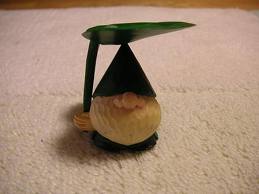
Think of the new-ish Ghibli movie that came out, The Secret World of Arietty (借りぐらしのアリエッティ), for an idea of what they’re about.
Summer!
When you think of summer, what do you think of? The answering of this question tells a lot about yourself and where you were raised. Most people’s memories of summer are from their childhood, spending the long weeks of summer vacation doing… whatever it is they did. I, for example, went to the Fourth of July fireworks festival which lets you know I’m probably American. Also, in my state, fireworks were illegal for individuals to purchase, so I don’t have many memories associated with the actual use of fireworks.
 Summer meant a family vacation, always going somewhere interesting, sometimes leaving our landlocked state for the ocean or camping, both summer staples. But, for me, summer really meant no school and lots of time to read and play the new video games I just bought. It was a relaxing, introverted few months, holing myself up in my room or the basement with whatever new book had just come out. Sometimes I went days without leaving the house.
Summer meant a family vacation, always going somewhere interesting, sometimes leaving our landlocked state for the ocean or camping, both summer staples. But, for me, summer really meant no school and lots of time to read and play the new video games I just bought. It was a relaxing, introverted few months, holing myself up in my room or the basement with whatever new book had just come out. Sometimes I went days without leaving the house.
Skip ahead a few years and ask me now what my idea of summer is, and you’ll get a much different answer. As I get in to the summer spirit, I find myself thinking of shooting fireworks in to the starry sky at a beach, breaking watermelons and having a seed spitting contest, going to a summer festival and, of course, ghost stories. Specifically Haykumonogatari (百物語).
This translated, means a gathering of 100 ghost stories. This tradition began in the Edo period among samurai hoping to prove their bravery by summoning a spirit. The idea is that you gather a group of brave friends, light 100 candles, then take turns telling scary stories. After each story, you blow out one of the candles. Once they have all been blown out, the room is pitch-black. You then count off the people in the room and legend has it there will be one extra person present at the end. Creepy, right? I haven’t had the chance to try it yet, nobody seems to want to do it with me and lighting a hundred candles seems like a lot of work, but I really want to do it once this summer.
Apparently, apart from the summoned spirit, the telling of ghost stories is supposed to attract wandering spirits to the location. In this way, Hyakumonogatari can actually haunt a place that was previously free of supernatural creatures. I’m not sure if these stories are supposed to only draw shinrei (心霊) or have the power to draw others such as yurei (幽霊), reikon (霊魂), shinrei (神霊) and the like, but my bet is that it depends on your luck. Plus, since these are stories of violent deaths and horrible accidents meant to scare people, you’re probably going to attract some pretty unhappy spirits, right? Things like akuryou (悪霊) and other evil spirits.
I suggest everyone who reads this goes out, buys a hundred tea candles and a book of ghost stories, and tries their hand at Hayakumonogatari! I’m going to do it pretty soon and will tell you if I get possessed by an evil spirit or something.
今回の妖怪
Yurei (幽霊), like their Western counterparts, are the souls of the deceased that have met with violent deaths, or have some strong desire keeping them tied to this world. This strong desire does not have to be a malevolent one, regret and love can keep spirits on this side of the veil, as well. Also, if the proper rights are not performed on the deceased, their spirit can end up trapped in the physical world, unable to transcend in to the afterlife.
Yurei had certain set characteristics that set them apart from their living counterparts, but unlike the white sheet cloaked over a Western ghost, they are a little more subtle. They do, however, wear white but otherwise have a human form, complete with long, disheveled black hair and usually wear Edo period style clothes. This is probably because stories of these kinds were very popular during that time, and Japan has romanticized this image even in to the contemporary.
The Kappa’s Promise
Since my last post was about Kappa, I figured the best thing to follow it with was this translation I did. It comes from a small town in the Nagano Prefecture and was part of my thesis project in college. Hope you enjoy the story of “The Kappa’s Promise” (カッパの約束)!
The Kappa’s Promise
The Saigawa River has a large bend as it flows, and beyond that the plains spread, and from behind it, the Obayama Mountains extended.
In May, the farms in that area, people swinging hoes and cows and horses tilling rice fields could be seen.
One day, A young man from the harbor brought his horse to do代かき. After tilling the rice field, water is spread, and a horse pulls a plow in the field, walking the perimeter until the clumps of earth are broken up.
Given that it was the afternoon, the young man led the horse out of the paddy field and left it behind to graze out in a wisteria mound, tying the bridle to a wisteria vine.
After the young man was done eating lunch, he lay down and rested for a short while.
Suddenly he came to his senses and saw the horse walking toward the direction of the river.
Foo, foo, hihiin!
He heard the horse neigh and because of that, in confusion jumped to his feet. And he saw that somebody was leading the horse by the bridle towards the direction of the river.
“Hey, Heyyy, Whoa! Whoa!”
While the young man was yelling in a loud voice for the horse to stop, he ran after it. The horse was in a state of being charmed towards the end of the road, kept going, and very recklessly was pulled in to the river. He was very astonished as, without change, the horse trod, “clip-clop, clip-clop” of its own accord toward the river. The young man, with incredible courage, tried to thwart this, and chased down the horse.
The young man, yelling in a loud voice and chasing behind, ran toward the horse and grabbed for the bridle, plunging in to the river. A Kappa was hanging from the horse.
Later, the horse was brought in to its own stable and the Kappa seemed to disappear. All of the family went searching everywhere for the Kappa, but it could not be found.
“Strange… The Kappa was hanging on until I got here…”
“Was it definitely a Kappa?”
Yup, definitely a Kappa.”
Everyone, thinking it strange, looked around everywhere and even overturned the manger at the stable’s entrance, for this place more than any other would the Kappa be expected to hide itself. And, beneath the overturned manger, a tiny Kappa was found.
“You! What were you trying to do, dragging my horse into the river, hey!”
The head of the house scolded the Kappa, and the Kappa rubbed its hands together in apology.
“I tried to lead our horse into the river, but the horse was too strong and so I got dragged all the way here. Somehow, must ask for forgiveness.”
It was seen that the dish on the Kappa’s head was completely empty of water. It was said that if the dish on a Kappa’s head is empty of water, the Kappa’s strength disappears. Despite trembling with fear, the Kappa pleaded with all its might. Upon seeing this, the head of the house thought the Kappa was very pitiable.
“I don’t have any intention of taking your life. But, don’t do it again!”
He told the Kappa. And then, they brought the Kappa to the white sand beaches of the Saigawa River and let it loose. The Kappa said,
“As a favor for saving me, whenever your family has a shortage, I will lend you whatever you want. Just write it on a piece of paper and send it down stream.”
It said. Then,
“However, whatever I loan to you, return in kind. If you don’t, then nothing shall be loaned to you.
It said and then the Kappa dove in to a deep pool in the white sand, swimming very happily.
Now, after that, everything went just as the Kappa had said. If they wrote the name of some good on a piece of paper and sent it down the river, without exception the thing would appear precisely as they had expected, arranged for them on the white sand beach.
As a matter of fact, at one time, because of a wedding, they borrowed some bowls from the Kappa.
When the wedding was over, everyone was tidying up.
“Oh no! One of the bowls we borrowed from the Kappa is gone!”
Count them again, it’s no problem.”
There isn’t anything we can do about it if it’s not there, just return what we have.”
“At any rate, the Kappa probably can’t count.”
And, with all the borrowed bowls but the missing one, they put on an unknowing face and returned them. After that, no matter how many times they wrote something on a piece of paper and sent it down the river, not one thing was ever lent to them again.
今回 の妖怪
Last time’s post was already about kappa, so I’m just gonna dig in to my bag of yokai and pull out this little guy. Abura Akago (油赤子) literally means “oil baby” and rightfully so, because this yokai drinks the oil out of lamps.
You know, back in the days before electricity. He came in to existence after living a normal human life and was cursed on his death to be reborn as this spirit, Abura Akago. What did he do to deserve such a strange reincarnation? He was an oil thief who pissed off the people who decided these kind of things by stealing oil from a Jizo statue every night. This was back when oil was a rather expensive thing, you recall. Yeah, so he got on the bad side of the Buddhas and now wanders Japan looking for places that still use oil in their lamps rather than electricity. So I guess now he just causes problems for campers and town festival organizers?
Kappa with A Side of Cucumber
I apologize for the long delay in getting this post up… I actually wrote half of it and then was distracted by my parents coming to visit from the states! Over Golden Week, I went to the cheap sushi chain known as Kappa Sushi (かっぱ寿司) for the first time. 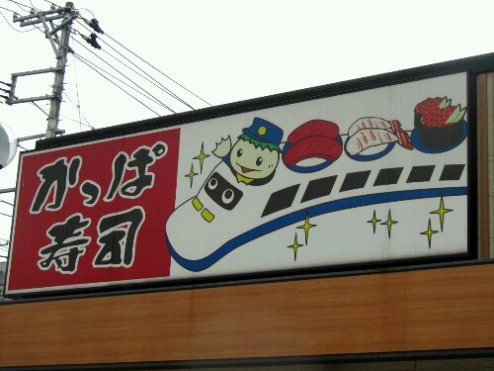
Now, if you’ve spent any amount of time in Japan, you’re probably either wondering how it took me this long, or more likely, why did I bother going at all? To answer the first, when I studied abroad in Japan, I didn’t eat fish, so sushi was basically out of the question. And when I came back to Japan on JET, I was placed in Hokkaido. Pretty sure there is no Kappa Sushi in Hokkaido. Our regular sushi isn’t much more expensive and infinitely better. As to why I even wasted my time and money? Because of their mascot and a kind of sushi called kappa-maki (河童巻き), or cucumber roll.
Kappa are river-dwelling yokai with a penchant for luring horses to their watery demise. Quite a bad habit for a creature living on an island country with no naturally wild horses! So, as you might expect, people got pretty pissed at these little guys for their pranks. But it didn’t end with horses… kappa also seem to enjoy Sumo wrestling, drowning little boys, pulling people’s entrails out as they took a bathroom break, and eating cucumber among many other things. This last one is what drew me to Kappa Sushi in Aomori over Golden Week.
Kappa Sushi is, other than the name of a crappy sushi restaurant, a kind of sushi in and of itself. It’s a cucumber roll, wrapped in rice and dried seaweed.
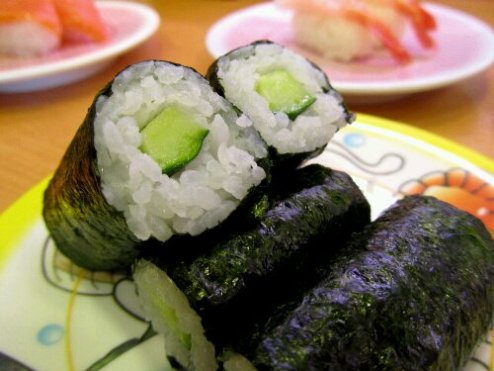
Since Japanese cucumber is about a billion times less bitter than the stuff you get in America, they’re not too bad. And really cheap! Originally, this sushi was made to appease kappa and stop them from killing horses and giving surprise prostate exams. Plus all that pesky riverside Sumo… In this, it’s kind of like another kind of sushi named after a slightly more divine creature. This sushi will be the topic of a later post.
Now, right after I said “a slightly more divine creature,” I reminded myself of an article I read in my college days which postulated quite intelligibly that kappa were once gods but had been reduced to mere monsters through human mistreatment of the rivers the kappa protected. Think of the stinky river god in Spirited Away. So, maybe we just got on their bad side so they’ve been reduced to Sumo wrestling on the beach. Oh, right… kappa like cucumber because it has a high water content. And water is important to river spirits.
今回の妖怪
The kappa (河童) was the focus of this week’s blog, so I’m gonna be lazy and make it this week’s yokai as well.
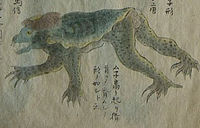
Kappa vary in shape and description depending on where you are in Japan, but the iconic kappa is kind of like a turtle with a bowl on its head. This bowl is filled with water and is the lifesource of the kappa. They are usually the size of adolescent humans and in addition to the bowl, have green skin, a shell, and a hooked beak. Their love of disembowelment and drowning has already been discussed so I’m afraid that’s all for the kappa today. There’s so much out there on these guys I’ll probably be revisiting them again one of these days.
Trouble With Tofu
This Saturday, I watched the newly released original animation Tofu Kozo (豆冨小僧) in 3D.

It was… definitely a children’s movie. With lots of dancing and pointless song sequences. But the yokai were, for the most part, based on real yokai. They took some liberties with appearance and nature I wasn’t particularly pleased with, but I’m a picky moviegoer.
Other than their creative license, the movie had little development and the plot was forced along by unbelievable and arbitrary dialogue and actions that had me checking my watch throughout the movie.
But it did get me thinking about the existence of yokai, through what purpose they exist.
*THE FOLLOWING CONTAINS SPOILERS*
The movie’s tagline ran something like, “Even though you’re a yokai, you can’t scare humans,” in reference to the main character, Tofu Kozo. This is followed by saying that there must be something that only you can do. The purpose of yokai in this movie would be, then, to scare humans. But Tofu Kozo can’t scare anyone as he is just so damn cute. And dies if he loses his block of tofu. So, assuming the purpose of any given yokai goes beyond the basic urge to continue existing, what would our hero’s purpose be? Here comes the spoiler, ready? If you really wanna watch this trainwreak of a movie, consider skipping down to the picture below.
Tofu Kozo gives away his tofu, i.e. his life, to save a human from the Grim Reaper (死神). Ignoring the stupid twist at the end where he comes back from the dead (this is a children’s movie after all…), what does this act of supreme sacrifice for the beings you supposedly exist singularly to terrorize mean? Again, it’s a children’s movie. But it does raise some questions as to what reason yokai truly exist. They exist to explain the unexplainable and give samurai chills (let’s be honest, everyone enjoys a good scare every once in a while).
And so, yokai exist to embody phenomenon that fall beyond the understandable. Thus, many yokai certainly do exist to scare us humans who are so afraid of things they don’t understand! So what of Tofu Kozo, the yokai who exists not to harm but help humans? Well, there are plenty of yokai whose existence is beneficial to humanity, but after some research, it seems Tofu Kozo isn’t among them… What’s that? He’s not an adorable yokai dropout? It would seem not.
今回の妖怪
This week we’ll be talking about the one and only Tofu Kozo (豆腐小僧)!

The hero of our story who had trouble scaring humans doesn’t need fear to harm his prey. Dressed in traditional robes and carrying a block of tofu emblazoned with a maple leaf, he would offer tofu to travellers out late on rainy nights. But not just any tofu! No, this tofu contained a fungus which would grow inside and kill the kind of people who eat free tofu in the backalleys of Kyoto. Some hero, huh? So remember, just say no to free tofu.











